Operation Tzur
ETHIOPIAN AIRLIFT
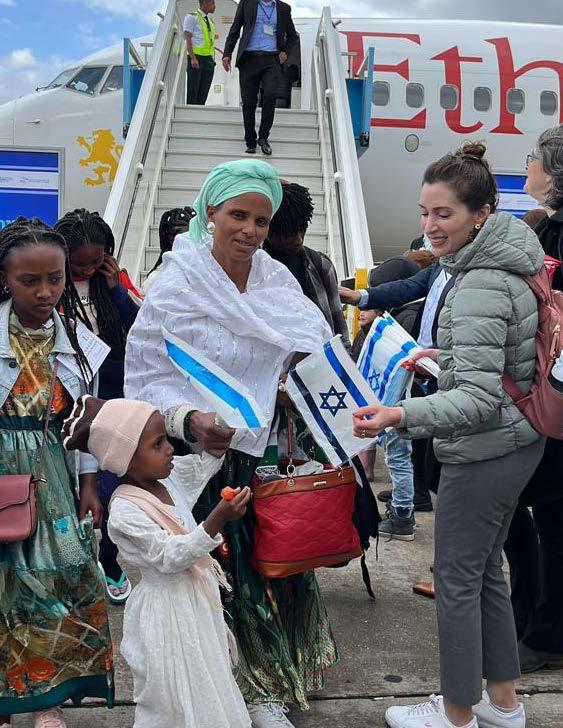
••• THE PROFOUND PROPHETIC SIGNIFICANCE OF YOM KIPPUR
(PAGE 4)
•••
INTERNATIONAL CHRISTIAN EMBASSY JERUSALEM // SEPTEMBER 2023 // USA EDITION
FROM JERUSALEM
The International Christian Embassy Jerusalem was established in1980 in recognition of the biblical significance of all of Jerusalem and its unique connection to the Jewish people. Today the ICEJ represents millions of Christians, churches, and denominations to the nation and people of Israel. We recognize in the restoration of Israel the faithfulness of God to keep His ancient covenant with the Jewish people. Our main objectives are:
• To stand with Israel in support and friendship;
• To equip and teach the worldwide church regarding God’s purposes with Israel and the nations of the Middle East;
• To be an active voice of reconciliation between Jews, Christians, and Arabs, and to support the churches and congregations in the Holy Land.
From its head offices in Jerusalem, the ICEJ reaches out into more than 170 countries worldwide, with branch offices in over 90 nations.
Our vision is:
• To reach every segment of Israel’s society with a Christian testimony of comfort and love, and
• To reach and actively represent to Israel the support of denominations, churches, and believers from every nation on earth.
The Christian Embassy is a non-denominational faith-based ministry supported by the voluntary contributions of our partners and friends across the globe. We invite you to join with us as we minister to Israel and the Jewish people worldwide by donating to the ongoing work and witness of the ICEJ.


WORD
CREDITS

ICEJ President Dr. Jürgen Bühler
USA Director Susan Michael
VP International Affairs Dr. Mojmir Kallus
VP Finance David van der Walt
VP Operations Barry R. Denison

VP International Spokesman David Parsons
VP AID & Aliyah Nicole Yoder
Managing Editor/Publications Director Laurina Driesse
USA Managing Editor Karen Engle
Staff Writer Anastasiya Gooding
Graphic Design/Illustrators Ryan Tsuen, Peter Ecenroad, Nancy Schimp
Photography Shutterstock, Adobe Stock, AP, AFP, JAFI, Flash90, Haaretz, Reuters, IDF, businessweek.com, Netafim, newatlas, SanDisk, Watergen, Waze, Wikimedia Commons, Levi Dörflinger, ICEJ Staff and Branches
The New King James Bible is used for all Bible references unless otherwise noted.
Word From Jerusalem is published by the International Christian Embassy Jerusalem. Reproduction in whole or in part without written permission is prohibited. Word From Jerusalem has no subscription price and is supported through contributions worldwide. The ICEJ USA Branch is a 501(c)(3) non-profit organization with offices in Tennessee, Florida, and Washington, DC. All gifts to this ministry are tax-deductible according to United States law.
INTERNATIONAL CHRISTIAN EMBASSY JERUSALEM - USA
Support our ministry online at: www.icejusa.org
Dear friends,
This past month we were repeatedly reminded why Israel desperately needs our prayers. Israel’s northern border situation has become increasingly tense as the Iranian-backed Hezbollah terror militia has built up a powerful arsenal of over 200,000 missiles and rockets to threaten Israel. The mass protests of judicial reforms within the country have also emboldened Hezbollah to provoke Israel into a military response. This terror militia not only represents a threat to Israel, but it is a deadly scourge to Lebanon itself—it has a firm stranglehold over the country and is siphoning off its wealth.
In response, Lebanese church leaders are increasingly bold about publicly criticizing Hezbollah, calling it a cancer spreading within their country. Let us stand with them in prayer, trusting God for a miracle. He can do the impossible!
Almost two years ago, my wife had two separate dreams that a spiritual battle was raging over Israel’s northern border, and much prayer was needed. The Lebanese border was a central focal point in one of our recent Rosh Chodesh prayer wave, which continues to grow worldwide, with over 70 nations now taking part in 12 straight days of prayer. Even after COVID-19, this prayer movement has continued to grow, a signal that prayer is a mighty strategic tool God wants us to employ in these last days.
In the book of James, the author, Jesus’ brother, encourages believers that “The prayer of a righteous person has great power as it is working” (James 5:16 ESV). Prayer is indeed working! As you pray for Israel and Lebanon, please also boldly pray for your own nation in faith.
In this month’s Word From Jerusalem, you’ll learn more about the situation in Northern Israel. But you’ll also read about the urgent situation surrounding Ethiopian Aliyah (pg. 15). And this month’s magazine also features in-depth teaching articles on the next feast in our 12-part series on the appointments: Yom Kippur (p. 4–9).
As you read this magazine, I am trusting God will encourage you to pray and stand with Israel more than ever through our ministry. I also pray you will experience God’s promise in your life that he who blesses Israel will be blessed (Genesis 12:3).
Many blessings from Jerusalem!
Dr. Juergen Buehler President International Christian
Embassy Jerusalem
COVER PHOTO: ICEJ and Jewish Agency for Israel staff greet recent Ethiopian Olim.
FOR MAGAZINE ARCHIVES visit www.icejusa.org/wfj
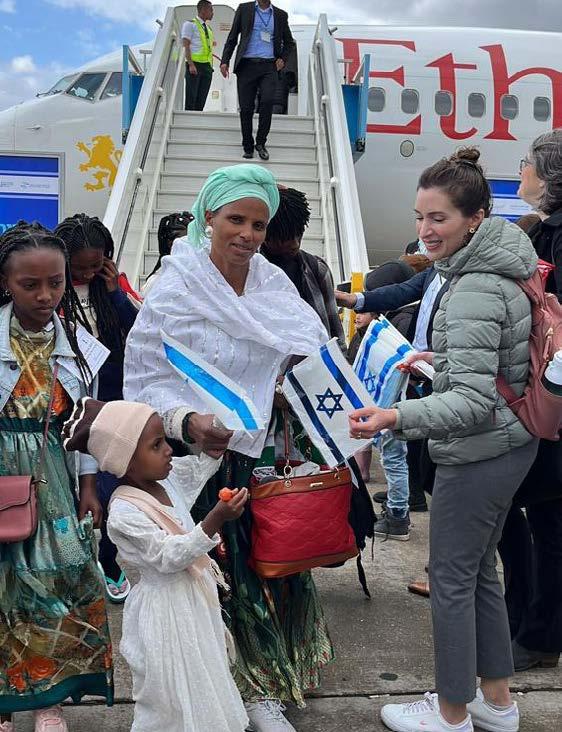
Operation TzurETHIOPIAN AIRLIFT THE PROFOUND PROPHETIC SIGNIFICANCE OF YOM KIPPUR (PAGE 4) INTERNATIONAL CHRISTIAN EMBASSY JERUSALEM // SEPTEMBER 2023 // USA EDITION FROM JERUSALEM
FROM THE PRESIDENT'S DESK
FROM JERUSALEM



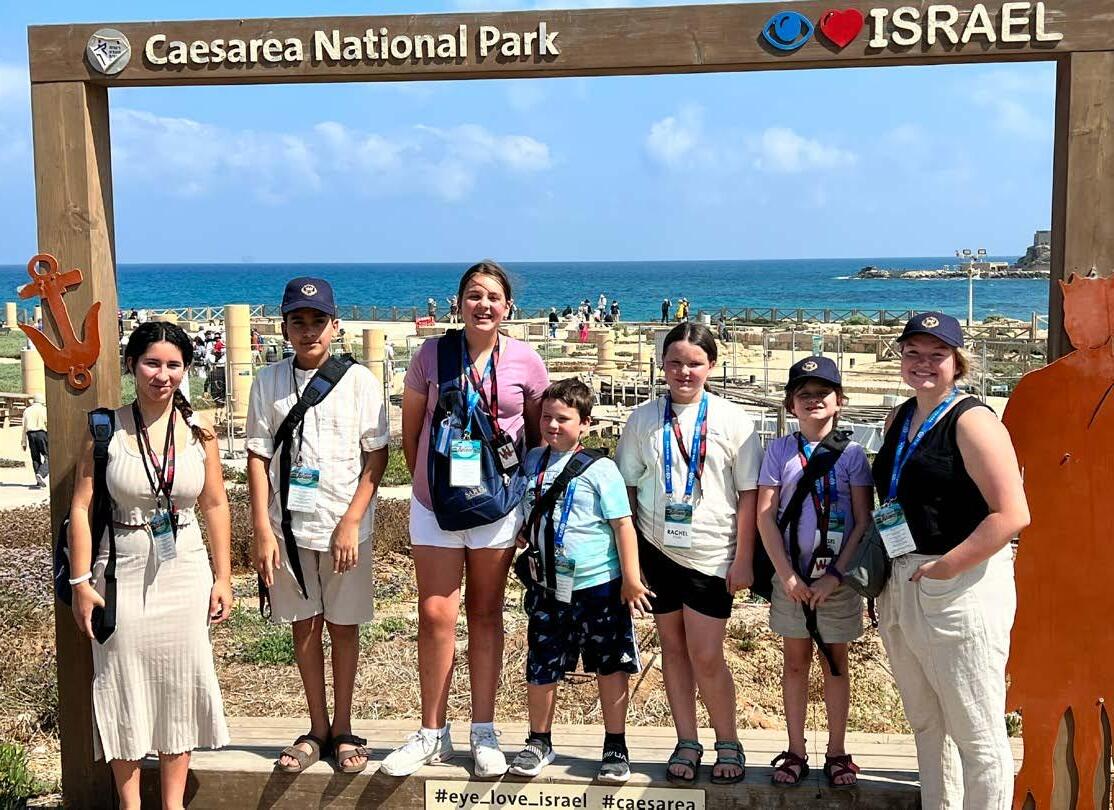

CONTENTS SEPTEMBER 2023 USA EDITION FEATURED TEACHING THE PROFOUND PROPHETIC SIGNIFICANCE OF YOM KIPPUR 4 YOM KIPPUR AND THE SECOND COMING OF JESUS 8 12 ICEJ FAMILY TOUR ICEJ SPONSORING URGENT ETHIOPIAN ALIYAH 15 14 SUMMER CAMPS PREPARE JEWISH YOUTHS FOR ISRAEL
SIGNIFICANCE OF YOM KIPPUR
 KAREN ENGLE, ICEJ USA MANAGING EDITOR
KAREN ENGLE, ICEJ USA MANAGING EDITOR
And the Lord spoke to Moses, saying:
“Also the tenth day of this seventh month shall be the Day of Atonement. It shall be a holy convocation for you; you shall afflict your souls, and offer an offering made by fire to the Lord. And you shall do no work on that same day, for it is the Day of Atonement, to make atonement for you before the Lord your God. … You shall do no manner of work; it shall be a statute forever throughout your generations in all your dwellings.”
(Leviticus 23:27–32; also Leviticus 16)
ICEJ TEACHING THE PROFOUND PROPHETIC
An Ibex (wild goat) in the Sde Boker desert area of Israel
The Day of Atonement, or Yom Kippur, is the holiest day on the Jewish calendar, both in biblical times and today. Though other feasts, like Passover, dealt with the individual, Yom Kippur was specific to the nation of Israel. In biblical times, it was the one day, once a year, when the entire nation’s sins were forgiven for the previous year.
Among the law God gave Israel at Mount Sinai was His detailed instruction for how to celebrate Yom Kippur. It was to be a feast kept forever— meaning, even today Israel should be keeping the feast. Israel was to humble or “afflict” their souls (fast or abstain from food), repent of any sin from the previous year, and rest. The high priest was to offer blood sacrifices to “make atonement” for the sins of the people, the priesthood, and the nation committed during the previous year. It was like starting a new year with a clean spiritual slate.
However, because most versions of the Bible translate the original word kippur as “atonement,” and because “atonement” is often inaccurately understood as the removal of sin or the reconciliation between God and man through Jesus’ sacrificial death, the profound meaning of what this feast is about for the nation of Israel is often lost for modern-day Bible readers.
T he original Hebrew word translated as “atonement” is kippur (and its verb form kaphar ). Kaphar means “To cover over, to reconcile, to conceal (sin).” The same word is found in the original Hebrew name for the Mercy Seat that covers the ark of the covenant—and it’s also the same Hebrew word for the English word “pitch” that God instructed Noah to cover the ark with, helping to protect the precious cargo inside. (Already, you can see how knowing the true meaning behind the word “atonement” might dramatically impact how we understand Yom Kippur.)
For this reason, Yom Kippur is known as the “Day of Covering.” And because it was also the day God judged the sins of the entire nation, it became known by another idiom: the “Day of Judgment.”
In modern Judaism, Yom Kippur follows 10 days of repentance from the start of Yom Teruah (also called Rosh Hashanah) known as the “Days of Teshuvah” or “Days of Awe.” For those 10 days, Jewish people confess sin and do good deeds in hopes their names will be found in the Book of Life before the gates of heaven close.
Yom Kippur in the Old Testament
Back when Israel was wandering in the desert, on this holiest day of the year on the Hebrew calendar, Israel’s high priest (a “type” or “shadow” of Jesus) had the main role for the day as an emissary for the entire nation—and all activity centered on the tabernacle (and later the temple in Jerusalem). God gave specific instruction for the high priest regarding cleansing, sacrifices, and clothing.
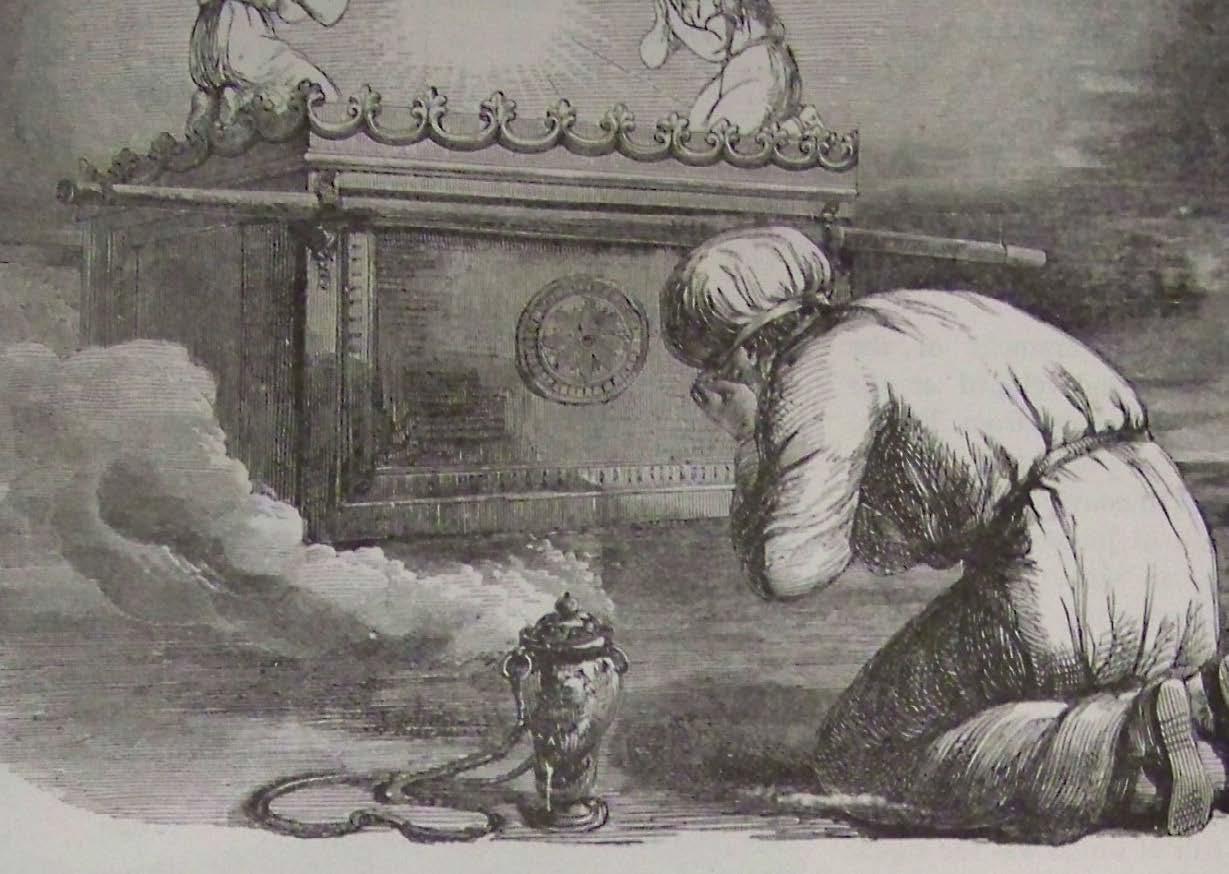
Cleansing
Yom Kippur was heavily focused on cleansing. Throughout this holy day, the priest bathed no fewer than five times and washed his hands and feet ten times in a golden basin—purifying himself after each sacrifice. But the people and the priests also needed cleansing from sin, and because the people’s sins made the tabernacle (and later the temple) unclean, God’s earthly sanctuary also needed cleansing. All this was done through the shedding of blood, for God had said, “It is the blood that makes atonement for the soul” (Leviticus 17:11).
the priest made 15 other offerings to the Lord. But the three primary offerings were:
• two goats – one sacrificed for God that would cover Israel’s sins and the other that would be let go into the wilderness for “Azazel”
• a bull – a symbol of strength, sacrificed for the priest
• incense – symbolic of prayer
After casting lots to determine which goat would be sacrificed and which goat released, the high priest slaughtered the bull and sprinkled its blood on the east side and in front of the Mercy Seat (a “shadow” of the heavenly throne of God) to cover his sins, his family’s sins, and the sins of the entire priesthood. He then poured incense onto hot coals before the ark of the covenant in the Holy of Holies, filling the entire chamber with smoke. Next, he slaughtered the goat of the sin offering and did the same with its blood to cover the people’s sins. Finally, after the high priest laid his hands on the head of the goat for Azazel, confessing onto the goat the sins of the people, another priest took this “scapegoat” into the wilderness and pushed it off a cliff.
T he congregation of Israel waited with bated breath outside the tabernacle: if God accepted the sacrifices, Israel’s sins would be covered for another year; judgment would be held off. Thus, what started on Yom Teruah—repentance and selfevaluation—culminated 10 days later on Yom Kippur as Israel’s sins were temporarily covered for the next year but not permanently removed. The animals’ blood also purged the earthly sanctuary of impurities as the priest combined the bull’s and the goat’s blood and sprinkled it on the horns of the altar in the courtyard.
Clothing
Sacrifices
On Yom Kippur, the high priest entered the Holy of Holies to approach God as Israel’s “mediator” with sacrifices to kaphar (cover) his sins and the peoples’ sins for one year, in effect closing the gap between God and His people and drawing them close. In addition to the regular daily offerings,
A fter completing the daily sacrifices on Yom Kippur, the priest changed from his regular colorful clothing into a white linen turban, robe, tunic, trousers, and sash—white representing purity. Every time the high priest entered the Holy of Holies, he bathed and changed into new linen garments, for they would be covered in blood from previous sacrifices.
ICEJ TEACHING
5 |WORD FROM JERUSALEM
The Mercy Seat, illustration from the 1890 Holman Bible
When all the Yom Kippur sacrifices were done, the high priest bathed again and changed into golden garments and completed the evening sacrifices.
Is Yom Kippur in the New Testament?

Just after Satan tempted Jesus in the desert, during which time Jesus, interestingly, neither ate nor drank, Luke tells us He went to a Nazareth synagogue and was handed the Isaiah scroll to read. Not coincidentally, He opened the scroll and began reading from Isaiah 61:1:
T he Spirit of the LORD is upon Me, because the He has anointed Me to preach the gospel to the poor; he has sent Me to heal the brokenhearted, to proclaim liberty to the captives, and recovery of sight to the blind, to set at liberty those who are oppressed; to proclaim the acceptable year of the Lord. (Luke 4:14–19)
Jesus then closed the scroll and said, “Today this Scripture is fulfilled in your hearing” (Luke 4:21).
T hat day, in His hometown and to his own brethren, Jesus claimed to be Israel’s Messiah and declared how His first advent on Earth was fulfilling Isaiah’s words. The phrase “preach the gospel to the poor” summarizes well His earthly ministry when Jesus proclaimed liberty to the captives and literally gave sight to the blind. However, Jesus inserted a phrase not found in Isaiah 61: “set at liberty those who are oppressed.” It comes from Isaiah 58:6.
Why?
Doing so was common in first-century Judaism. Rabbis would weave various verses and passages together to communicate a principle. So let’s consider that phrase in its context:
You will not fast as you do this day, to make your voice heard on high. Is it a fast that I have chosen, a day for a man to afflict his soul? Is it to bow down his head like a bulrush, and to spread out sackcloth and ashes? Would you call this a fast, and an acceptable day to the Lord? Is this not the kind of fasting I have chosen: to loose the chains of injustice and undo the heavy burdens, to let the oppressed go free, and that you break every yoke? (Isaiah 58:4–6)
In this passage, Isaiah notes that God will one day “let the oppressed go free” on “an acceptable
day to the Lord.” This phrase was only declared on Jubilee, when every fiftieth year, on Yom Kippur, Israel was to proclaim freedom throughout the land to all its inhabitants. Debts were to be forgiven, sold-off property returned to its original owner, and slaves returned to their clans; the land was also to lie fallow.
By inserting that phrase drawn from Isaiah 58 “set at liberty those who are oppressed,” Jesus was alluding to what would soon come: His crucifixion and shed blood on the cross that would release anyone who believed from being enslaved to sin—Jew or gentile. However, we mustn’t miss some other words Isaiah used— specifically, “fast” and “afflict,” code words for Yom Kippur. Because Jesus quoted from Isaiah 58, which likely points to Yom Kippur on a Jubilee year, and because He declared Scripture was “fulfilled in your hearing,” some scholars believe Jesus was reading Isaiah 61 during a first-century Yom Kippur service.
But don’t miss another profound detail in Luke: Jesus stopped mid-phrase in verse 2 of Isaiah 61, closing the scroll. If we pick up there to the end of verse 3, we read:
… and the day of vengeance of our God; to comfort all who mourn, to console those who mourn in Zion, to give them beauty for ashes, the oil of joy for mourning, the garment of praise for the spirit of heaviness; that they [Israel] may be called trees of righteousness, the planting of the LORD, that He may be glorified.
Beneath Jesus’ declaration in Isaiah 61 of being Israel’s long-awaited Messiah, there’s a call to corporate repentance. Jesus’ first coming was as the suffering servant (Isaiah 53) to the individual. Vengeance for God’s enemies would come later—on a future Yom Kippur when He returns to the Mount of Olives to right all wrongs and fight Israel’s enemies. Isaiah says on that day He will comfort His people who are mourning in Zion (Jerusalem) and replace their sorrow with gladness and joy—and Israel will be the “trees of righteousness, the planting of the Lord” He always intended for them to be.
And it will be all for one reason: that He may be glorified.
What Yom Kippur Points To Yom Kippur provides prophetic insight regarding Jesus’ return, the restoration of national Israel, and the final judgment of the
world. Every year on Yom Kippur the high priest entered the “copy” of the heavenly Holy Place. But the writer of Hebrews says when Jesus ascended to heaven, it was as Israel’s Great High Priest, the mediator of a new covenant; He entered the Most Holy Place in the heavenly tabernacle, not by the blood of goats and calves to cover sin for one year but “once for all by his own blood, thus obtaining eternal redemption” (Hebrews 9:12). Jesus’ sacrifice accomplished not just a covering for sin but the removal of it.
On that day when Jesus comes out of the heavenly tabernacle upon which the earthly pattern was based, now cleansed by His blood— giving His people access into the heavenly Holy of Holies—Zechariah 12:10 tells us that national Israel will see Him as He truly is: “They will look on Me whom they pierced. Yes, they will mourn for Him as one mourns for his only son.”
T hose who put their faith in Jesus and His death on the cross experience removal of sin the moment they believe. Redemption for the individual is done, but God’s promises for Israel’s national restoration remain. Paul teaches in Romans 11:26–27 that when God’s people embrace Jesus as their Messiah, acknowledge their offense, and seek God’s face, He will not just cover their sins but remove them as far as the east is to the west: “The Deliverer will come out of Zion, and He will turn away ungodliness from Jacob; for this is My covenant with them, when I take away their sins.”
T his is the prophetic fulfillment of Yom Kippur—when Jesus returns to the Mount of Olives in Jerusalem, is received by His people, and secures victory over their enemies. It’s a day for Israel Zechariah foresaw, when fasts like Yom Kippur will become times of joy:
T hus says the Lord of hosts: The fast of the fourth month, the fast of the fifth, the fast of the seventh [Yom Kippur], and the fast of the tenth, shall be joy and gladness and cheerful feasts for the house of Judah.
(Zechariah 8:19)
T hough Jesus was indeed a suffering servant at His first coming, He will return as Isaiah prophesied on “the day of vengeance of our God” and fulfill Yom Kippur as conquering King. The spiritually dead will be judged, but he who is victorious, says the apostle John, will be dressed in white (Revelation 7:9), cleansed by the blood of the Lamb—and never blotted out from the Book of Life (Revelation 3:5).
6 | SEPTEMBER 2023 ICEJ TEACHING
In the book of Exodus, God’s instructs the children of Israel to build Him a sanctuary in which to dwell:
And let them make Me a sanctuary, that I may dwell among them. According to all that I show you, that is, the pattern of the tabernacle and the pattern of all its furnishings, just so you shall make it.
(Exodus 25:8–9)
This tabernacle was built by the Israelites in the wilderness around 1450 BC. It was the first “temple” dedicated to God and where the Ark of the Covenant was housed. Solomon’s First Temple would come later, followed by the Second Temple in Jesus’ day.
However, these earthly sanctuaries where all the Yom Kippur sacrifices were performed were mere copies or “shadows” of the true, heavenly sanctuary. The following passages reference both—and the cleansing work in the heavenly tabernacle of Jesus, our Great High Priest, on Yom Kippur:
But Christ came as High Priest of the good things to come, with the greater and more
THE EARTHLY SANCTUARY, A COPY AND SHADOW
KAREN ENGLE, ICEJ USA MANAGING EDITOR
perfect tabernacle not made with hands, that is, not of this creation. Not with the blood of goats and calves, but with His own blood He entered the Most Holy Place once for all, having obtained eternal redemption.
(Hebrews 9:11–12)
For Christ has not entered the holy places made with hands, which are copies of the true, but into heaven itself, now to appear in the presence of God for us; not that He should offer Himself often, as the high priest enters the Most Holy Place every year with blood of another—He then would have had to suffer often since the foundation of the world; but now, once at the end of the ages, He has appeared to put away sin by the sacrifice of Himself. And as it is appointed for men to die once, but after this the judgment, so Christ was offered once to bear the sins of many. To those who eagerly wait for Him He will appear a second time, apart from sin, for salvation.
(Hebrews 9:24–27)
Therefore, brethren, having boldness to enter the Holiest by the blood of Jesus, by a new and living way which He consecrated
THE TABERNACLE OF MOSES

for us, through the veil, that is, His flesh, and having a High Priest over the house of God, let us draw near with a true heart in full assurance of faith, having our hearts sprinkled from an evil conscience and our bodies washed with pure water. Let us hold fast the confession of our hope without wavering, for He who promised is faithful. (Hebrews 10:19–23)
Keep learning about the significance of God’s feasts in the October issue of Word From Jerusalem, when we will explore the Feast of Tabernacles.
MODERN YOM KIPPUR CELEBRATIONS
Before the temple was destroyed in AD 70, Yom Kippur services were more clearly defined than today. Without a temple, adjustments had to be made.
Today, before the start of Yom Kippur at sundown on Tishri 10 when fasting commences, families share a meal. Like on the weekly Sabbath, no work is done, and families light special holiday candles before the feast starts. Synagogues host special services, where both the rabbis and the people wear white. To atone or “cover” sin, the Jewish people fast, pray, repent, ask God for forgiveness, and do good deeds. Everyone wishes each other a happy Yom Kippur, saying things like: “I wish you a day of forgiveness, mercy, and blessings on your day of repentance.”
T he fast continues until sundown the next day, when a final blast of the shofar sounds, and the fate of each person is sealed for the upcoming year. Jewish families then enjoy a “break-the-fast” meal.
HOLY OF HOLIES THE HOLY PLACE ARK OF THE COVENANT ALTAR OF INCENSE TABLE OF SHOWBREAD GOLDEN LAMPSTAND BRONZE LAVER ALTAR OF BURNT OFFERINGS Outer Court Yard Entrance Gate S N W
7 |WORD FROM JERUSALEM
YOM KIPPUR and the SECOND

COMING
OF JESUS
 B Y DAVID R. PARSON S ICEJ VICE PRESIDENT AND SENIOR SPOKESMAN
B Y DAVID R. PARSON S ICEJ VICE PRESIDENT AND SENIOR SPOKESMAN
ICEJ TEACHIING
There is a connection between Jesus being tested and dying at Passover and then fulfilling the further priestly role foreshadowed in Yom Kippur when he ascended to the Father and placed His blood on the ark in the heavenly temple on behalf of all who believe in Him. Yet Yom Kippur has further prophetic significance, especially in connection with the second coming of Jesus. This also is born out in the New Testament, as seen in the parable of the Wedding Feast.
Parable of the Wedding Feast
T he Parable of the Wedding Feast told by Jesus appears in Matthew 22:1–14 and is paralleled by the Parable of the Great Banquet in Luke 14:7–24. In Second Temple times, a wedding was a sacred and joyous thing. The feasting and merriment even lasted for up to a week or more, and it was considered a mitzva (good deed) to share in the joy of the occasion. When Jesus told this parable, His hearers understood the picture He was creating because such traditional weddings were a part of Jewish culture.
T hus we read in Matthew 22 that a certain king arranged a marriage for his son and invited the usual list of nobles and elite, but they all had better things to do—and some even killed the king’s servants. So he sent out more servants to invite people from the highways and hedges— both bad and good. Luke 14:15–24 describes it as “a Great Banquet,” but presumably, it is a wedding feast, as the preceding verses in Luke 14:7–14 have Jesus cautioning us to take the lowly seats at wedding feasts, lest we get bumped from the front row. So these are profoundly similar parables.
Matthew says the initial invitees were too busy with their businesses and families, while Luke says the high-and-mighty all made excuses for why they could not attend. But Matthew 22 has an extra scene. Right before the wedding starts, the king comes into the waiting room and inspects all the guests. One man did not have on a wedding garment. The king confronted him, but the man remained silent and offered no excuse. Then the king ordered that he be bound and thrown into outer darkness.
T his moment of inspection of the wedding garments is incredibly instructive! The Fall feasts, or “appointments”—Yom Teruah (Feasts of Trumpets), Yom Kippur (Day of Atonement), and Sukkot (Tabernacles)—are all tied together, and all portend the Second Coming of Jesus.
They speak prophetically of the coronation of Jesus as King and the Wedding Feast of the Lamb.
T he Parable of the Wedding Feast assumes the listener is familiar with the ancient Oriental custom of the host providing garments for the guests who were invited to a royal feast. In ancient times, kings and wealthy men had wardrobes filled with fancy garments (today called “caftans”) as a symbol of their wealth and glory. Examples can be found as follows:
• Genesis 45:22 – Joseph gives all his brothers’ garments (but three to Benjamin).
• Judges 14:12 – Samson offers 30 linen garments and 30 changes of clothes to answer his riddle.
• 2 Kings 5:22 – Naaman promises 10 garments plus gold and silver to Elisha.
• 2 Kings 10:22 – King Jehu gives vestments from wardrobe in the temple of Baal.
• Esther 6:8 and 8:15 – Haman says: “dress him in royal robes” (Mordechai is the one dressed in royal apparel).
Even posh country clubs and restaurants today have similar strict dress codes, and small closets are stocked with appropriate dinner jackets and other attire if an improperly dressed guest warrants entry.
In the parable of Jesus, it would have been a great insult to the king to refuse to wear the garments freely offered to the guests. The man caught wearing his old clothing learned what an offense it was as he was forcefully removed from the celebration.
our shame ourselves is to be clad in “filthy rags” (Isaiah 64:6). In the book of Revelation, we see those in heaven wearing “white robes” (Revelation 7:9), and we learn that the whiteness of the robes is due to their being washed in the blood of the Lamb (verse 14). We trust in God’s righteousness, not our own (Philippians 3:9). Further, the true church is described as “not having spot or wrinkle” (Ephesians 5:27).
Finally, in Revelation 19:6–9, a great multitude has gathered for the marriage of the Lamb, and “His wife has made herself ready: And to her it was granted to be arrayed in fine linen, clean and bright, for the fine linen is the righteous acts of the saints. Then he said to me, ‘Write: “Blessed are those who are called to the marriage supper of the Lamb!”’”
Just as the king provided wedding garments for his guests, God provides salvation for mankind. Our wedding garment is the righteousness of Christ, and unless we have it, we will not be allowed into the Wedding Feast of His dear Son.
T he great preacher Charles Spurgeon, commenting on the Parable of the Wedding Feast, noted that it is the custom in the East for a king to provide robes for his guests. These wedding garments were a sign of grace, freely given and received, and wearing it was a sign of respect for the king and for his son, the bridegroom. So why was the one man speechless? Making excuses is the easiest game in town. But here, there was nothing to be said. He could have easily put on a beautiful flowing robe provided by the king, but he simply did not care. And he stands as a symbol and warning to us all to take heed on how we prepare for our appearance before God.
At the Feast of Trumpets, the shofar sounds to awaken our souls to a time of awe and introspection, as we are about to stand before the Lord. On Yom Kippur, the verdict is delivered whether we are to be found naked and ashamed or worthy of His grace. If you pass muster, it is time to rejoice in your salvation and join the wedding feast—the Feast of Tabernacles!
T his was Jesus’ way of teaching the inadequacy of self-righteousness. From the beginning, God provided a “covering” for our sin. Adam and Eve tried to cover their nakedness and shame with fig leaves, but God replaced them with skins of animals, which meant a life had been sacrificed (Genesis 3:7, 21). To insist on covering
We now find ourselves in that time of preparation before the Wedding Feast. This Yom Kippur on September 24–25, let us make sure we have clothed ourselves with the righteous garments God has provided through Jesus, our High Priest, and His blood already sprinkled on the mercy seat in heaven.
ICEJ TEACHIING
We now find ourselves in that time of preparation before the Wedding Feast.
9 |WORD FROM JERUSALEM
MOUNT EBAL AMULET AFFIRMS ISRAELITE WORSHIP OF “YAHWEH”
 BY JONATHAN PARSONS, PUBLICATIONS ASSISTANT
BY JONATHAN PARSONS, PUBLICATIONS ASSISTANT
“That men may know that thou, whose name alone is JEHOVAH, art the most high over all the earth.” (Psalm 83:18 KJV)
Recent test results on a small lead amulet found in a sifting project linked to Joshua’s Altar on Mount Ebal in northern Samaria has confirmed that it contains the oldest known proto-Hebraic inscription of the divine name “Yahweh” (in Hebrew יְהוָה). This predates by some 600 years the “priestly blessing” silver amulets from the time of King Hezekiah found on Bible Hill in Jerusalem. Along with an ancient engraving of the name “Yahweh” in Egyptian hieroglyphics found decades ago in northern Sudan (then-Upper Egypt), the lead pendant provides further evidence that Israelite worship of this Creator God has been around for a long time, just as the Bible says.
T he small, folded amulet was found in 2019 among spoil material taken from a dig many years earlier at Joshua’s Altar on Mount Ebal. Its two leaves were too brittle to open and read, so the find was transferred to the Institute of Theoretical and Applied Mechanics in Czech Republic, where extensive X-ray imaging was used to decipher the etched words inside and outside the locket. The results indicated protoHebraic lettering, which some scholars consider the world’s earliest alphabet.
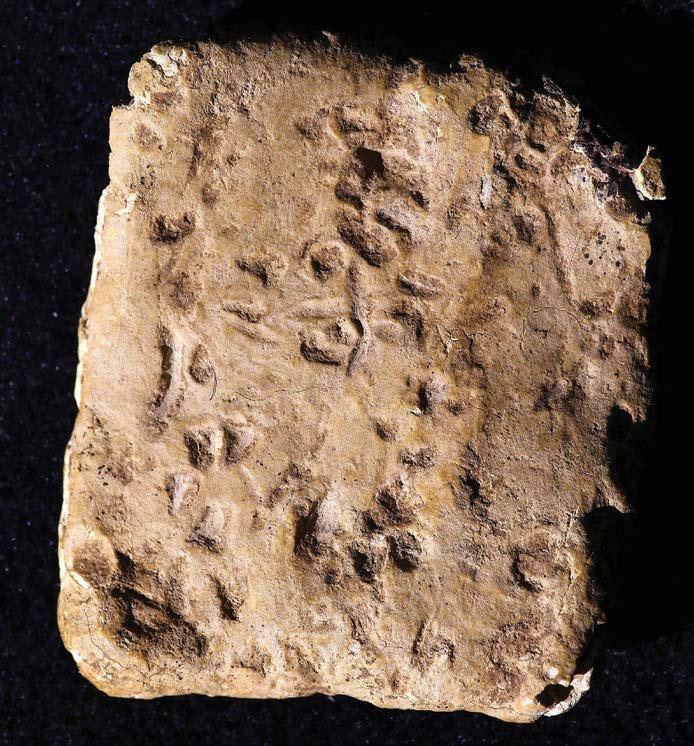
T he amulet contained 40 proto-alphabetic letters reading: “You are cursed by the god yhw— cursed. You will die, cursed, you will surely die.”
T his correlates with the events recorded in Deuteronomy 27:11–13 when the 12 tribes of Israel were commanded to divide in half
and stand on two opposite hillsides—Mount Gerizim (the Mountain of Blessing) and Mount Ebal (the Mountain of Cursing)—and recite aloud divine blessings and curses to each other.
altar and the ramp leading up to it, instead of steps, fit the biblical instructions for building the altar of the Lord in Exodus 20:25–26 and Joshua 8:31. The original dig also turned up charred bones of only kosher animals, as was required in Israelite sacrifices to Yahweh.
T he now-deciphered “curse” amulet with the name “Yahweh” predates by six centuries the two silver leaves found in a burial cave in the Hinnom valley in Jerusalem in 1979 by noted archaeologist Prof. Gabi Barkay. These finds recited the Priestly Blessing of Numbers 6:24–26, including the name “Yahweh.”
Interestingly, the name “Yahweh” is inscribed in Egyptian hieroglyphics on a pillar of the temple of Soleb today in northern Sudan. This temple and inscription date to the late fourteenth century BC, when Pharaoh Amenhotep III recorded in stone a list of his foreign enemies, among them “the land of the nomads of Yahweh.”
T he late Israeli archaeologist Adam Zertal excavated a large stone platform on Mount Ebal in 1980 and identified it as Joshua’s Altar. Zertal’s discoveries have often stirred controversy in academic circles because he preferred to publish his findings in books rather than in peer-reviewed journals where scholars could critique his work. However, the recent test results on the “curse” amulet have only added to the evidence that the location is indeed the authentic site of Joshua’s Altar.
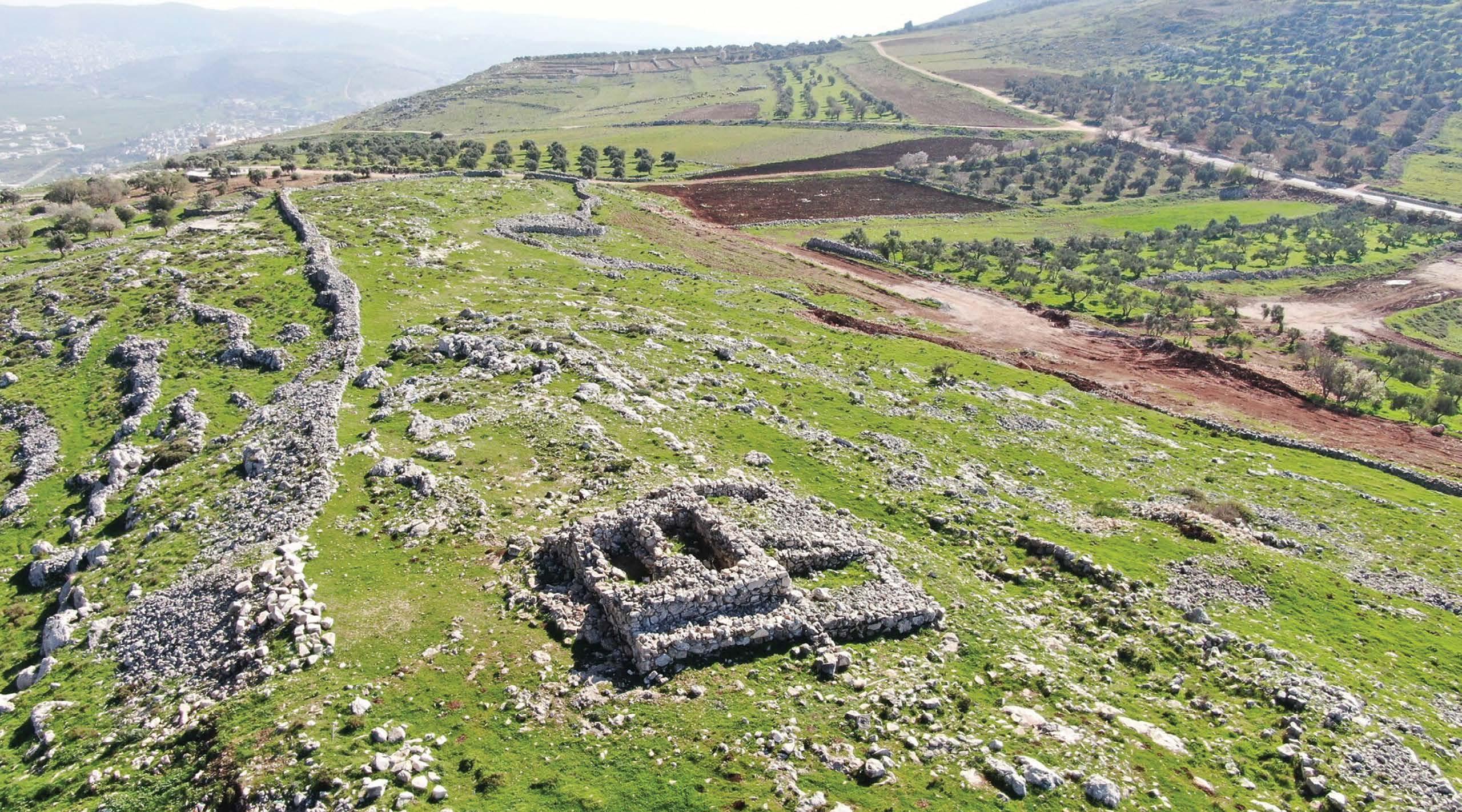
T he site on Mount Ebal also contained pottery shards and scarab seals of Pharaoh Ramesses II, dating back to circa 1200 BC—around the time of Israel’s entry into the land of Canaan under Joshua. The unhewn stones that make up the
T he divine name “Yahweh” is used thousands of times in the Hebrew Bible, usually translated as LORD, Adonai, or Jehovah, but the text indicates it was first revealed to Moses in the burning bush experience—specifically in Exodus 3:15. Since then, God’s ineffable name has been written and inscribed on many pages, walls, and amulets. The recent deciphering of the “curse” amulet from Mount Ebal provides further evidence that the Jewish people have worshiped Yahweh for some 4,000 years—while also affirming the Bible’s accuracy and Jewish claims to the Land of Israel.
ICEJ TEACHING
Curse amulet from Mount Ebal (Jaroslav Valach)
Joshua’s Altar on Mount Ebal (Shomrim Al Hanetzach)


TOUR ISRAEL WITH OTHER PASTORS AND LEADERS ENVISION CONFERENCE • Meet, pray, and fellowship with church and ministry leaders from around the world • Hear from proven Christian leaders about how God is leading them in our day • Learn more about Israel’s amazing modern-day restoration • Engage with Israeli officials, community leaders, and local pastors Tour Sites: Caesarea Maritima • Mt. Carmel • Tel Dan • Capernaum Sea of Galilee • Mount of Beatitudes • Jordan River Baptism Masada • Camel Ride • Mount of Olives • Jerusalem’s Old City Garden Tomb • Temple Mount • Yad Vashem • City of David Western Wall • and many more INTERNATIONAL CHRISTIAN EMBASSY JERUSALEM PO Box 332974, Murfreesboro, TN 37133 • (615) 895-9830 tours@icejusa.org • Register at: www.icejusa.org/envision JANUARY 23 – FEBRUARY 1, 2024
ICEJ SUMMER FAMILY TOUR 2023
Families Building Lifelong Memories Together in Israel



 BY LIESL MAAS, TOURS CODIRECTOR
BY LIESL MAAS, TOURS CODIRECTOR
With the warmth of summer filling the air, the ICEJ USA Branch embarked on its first-ever Summer Family Tour to Israel. The tour’s purpose was to give families with children—younger and older—grandparents, and even extended family the opportunity to experience the land of the Bible together. Every day was specially put together with a mixture of adventure, biblical history, and an opportunity to learn more about the Jewish people and the Land of Israel. The group came prepared for a 10day tour of Israel, but what they got exceeded all their expectations.
Participants visited the beautiful ruins of Caesarea Marittima, where the gospel went forth to the gentiles. They walked atop Mount Carmel, where Elijah defended the worship of our God. They took a boat ride over the Sea of Galilee, imagining themselves watching Jesus calm the storms and walk on the water. The Bible came to life before everyone’s eyes as they sat listening to the Word of God read out loud at the Mount of Beatitudes and as they walked down the Mount of Olives in Jerusalem toward Gethsemane, picturing Jesus’s final hours on Earth before He died for us. Each family had time to pray, worship the Lord, and take communion together at the Garden Tomb. It was moving for the whole group to witness some kids and parents get baptized in the Jordan River, where John the Baptist baptized Jesus and many others. A tour participant gave her life to the Lord on the shores of the Galilee one morning, and the presence of the Lord was with the group every place they went. Everyone on the trip felt something special was taking place as each day continued.
But what would a family tour to Israel be without some adventure
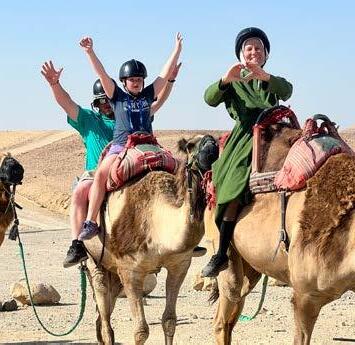
and fun along the way! They kayaked down the Jordan River, rode camels in the desert, herded goats, hunted for scorpions at night, and enjoyed a bonfire before sleeping in a Bedouin tent—a highlight for kids, parents, and grandparents alike! All this brought about marriage and family team-building lessons everyone enjoyed.
Finally, the group had the incredibly special opportunity to visit the ICEJ Haifa Home for Holocaust Survivors, where they met a Survivor of the Holocaust and heard her story of how she survived this terrible time in history. ICEJ Deputy AID Director Yudit Setz spoke about ICEJ’s Holocaust project ministry and all that is being done to help these precious individuals with basic physical needs. At the end of the visit, the kids came around the lady who spoke to the group and hugged her. She was so touched and happy to see them, and the feeling was mutual.
The warmth of summer doesn’t bother you when you are in Israel standing under the fresh waterfalls at Ein Gedi, where David hid from Saul, swimming in the Sea of Galilee, where Jesus fed the multitudes, or floating in the waters of the famous Dead Sea. There is nothing better than spending a summer vacation in Israel—for these families, their summer trip to Israel proved to be a special memorymaking, life-changing 10 days that they will have with them forever, affirmed by one tour participant Francine from Tennessee who said, “What a blessed and wonderful experience together.”
What plans do you and your family have for the summer of 2024? Consider coming to Israel on a life-changing 10-day tour that will build precious lasting memories for you and your family forever!
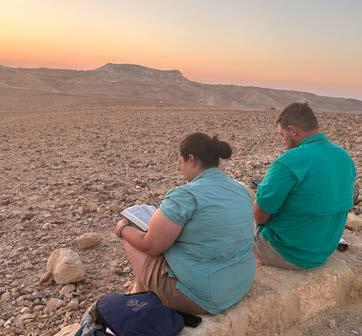
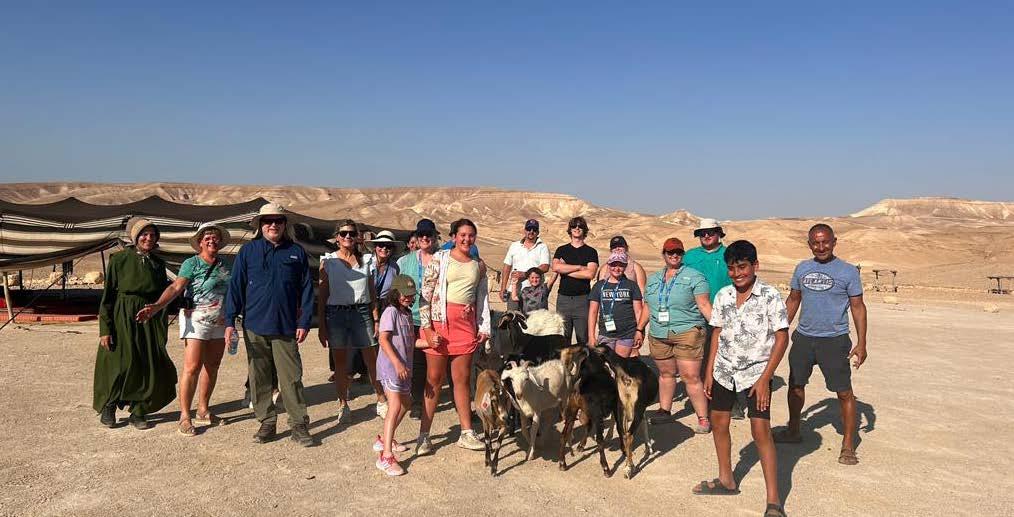
12 | SEPTEMBER 2023 ICEJ USA REPORT
For more information contact: tours@icejusa.org
Adopt a Corner of the Christian Embassy Nature Park

The Be’eri Forest in the western Negev is truly one of the most popular places in nature in Israel. Scores of Israelis come to this forest to hike, bike, picnic, and enjoy getting out in nature, and they especially flock here in winter to see the bright carpets of red anemones that blossom during the rainy season. Many also come to visit the ANZAC Memorial, an important site in the story of modern Israel’s national rebirth.
However, this special corner of the Be’eri Forest has been heavily burned and damaged over recent years by fire kites and balloons launched by terrorists in nearby Gaza.

Yet now, the ICEJ has an exciting opportunity to replant and restore this area and make it more beautiful than ever. We are revitalizing this forest in partnership with Keren Kayemeth LeIsrael – Jewish National Fund (KKL – JNF), and the area will be renamed:
The Christian Embassy Nature Park
The ANZAC Memorial area of the Be’eri Forest especially needs reviving—it marks the spot where Australian and New Zealand cavalry forces (ANZACs) serving under British Gen. Edmund Allenby camped one night in late October 1917 during their campaign to free “Palestine” from Ottoman rule. Allenby and his troops had failed several times to push the Turks out of Gaza. But a new plan of attack was hatched that night as they camped just outside Gaza.
That evening, Allenby sent the ANZAC cavalry through the Negev desert to stage a surprise attack on Beersheba to the east. The battle would be difficult, as the Ottoman forces were waiting in trenches and armed with machine guns. But as the Australian and New Zealand horsemen rode for hours along a winding desert path, their mounts became very thirsty. And as the horses approached Beersheba, they smelled the water in the ancient wells of the biblical town, and nothing was going to stop them from reaching that water.

Historians consider the Battle of Beersheba to be the last successful cavalry charge in history. The ANZACS rode their horses straight through the Turkish lines and sent them reeling northward. The victory was so complete that just two days later, on November 2, 1917, the British government issued the famous Balfour Declaration committing to establish a Jewish national home in Eretz Israel.
Thus, the ANZAC Memorial marks a key moment in modern Israel’s national rebirth, and the ICEJ has a rare opportunity to help care for the forested area where this historic monument sits.
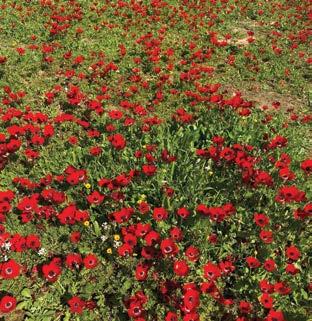

Please join us in helping to replant and restore this special part of the Be’eri Forest. It will not only beautify nature but demonstrate to Israeli visitors that Christians care about them and their extraordinary land.
Help restore this beloved Israeli forest by adopting a plot in square meters for replanting and renewal.

ICEJ TEACHING
Donate today at: www.icejusa.org/ trees
FOREST IN ISRAEL 13 |WORD FROM JERUSALEM
HELP RESTORE THE BE’ERI
BALTIC SUMMER CAMPS PREPARE JEWISH YOUTHS FOR LIFE IN ISRAEL
 BY ESTER HEINZMANN, ICEJ GERMANY
BY ESTER HEINZMANN, ICEJ GERMANY
Over one million Russian-speaking Jews have immigrated to Israel since the Iron Curtain fell in 1989, but hundreds of thousands of Jews are still left in the former Soviet republics. This summer, as the war keeps raging in nearby Ukraine, several hundred Jewish youths are preparing for their own move to Israel by attending Aliyah summer camps being held in the Baltic states with the help of the International Christian Embassy Jerusalem.
T he series of summer camps were run by the Jewish Agency for Israel (JAFI) with support from the ICEJ. One Aliyah camp opened in late June in Latvia with 101 Jewish participants from ages 7 to 17. Among them were 30 young Ukrainian Jews displaced from the war, with the rest coming from the Baltic states.
Another summer camp just concluded in Vilnius, Lithuania, with 141 Jewish youths participating, including 133 Ukrainian Jews. A third Aliyah youth camp was held in Latvia in August and two more in major Russianspeaking cities elsewhere. In total, over 1,000 Jewish children took part in these summer camps.
T hroughout the week, the youngsters not only learned more about Israel as their future home but also reconnected to their Jewish faith, which was suppressed during Soviet times. The camps provide special Aliyah preparation seminars where trained staff and volunteers encourage
and advise on various aspects of immigrating to Israel.

But these Jewish kids and teenagers were not without plenty of planned time for fun— including swimming, volleyball, and foam parties. They learned Israeli folk dances set to Middle Eastern music that echoed through the surrounding forests, producing smiles and laughter. In addition, they participated in traditional Shabbat observances on Friday evenings, like candle lighting and kiddush (a blessing said over grape juice before the meal).
A t the recent Aliyah camp in the Latvian seaside resort of Saulkrasti, campers stayed in an idyllic vacation complex, and everyone quickly made new friends. Located at the edge of an impressive nature reserve, the camp offered various programs, and amid the hot summer weather, a dip in the Baltic Sea was most refreshing.
Camp counselors shared insights about Israel— the innovative Start-Up Nation and haven for the Jewish people. And as the Russia-Ukraine war was dragging on not so far away, the youngsters had time and ample reason to reflect on what a move to Israel will mean for them.
T he young campers also learn about special Aliyah youth programs run by JAFI, which offer them the opportunity to complete their high school education in Israel and/or study at top universities in the country. JAFI’s investment
in these SELA and NAALE programs has born great fruit, as more than 30,000 Jewish teenagers have graduated from these programs over the past 30 years. Most choose to remain in Israel for good, with parents and siblings soon following.
Currently 700 Jewish youths are expected to enter the SELA program and another 700 in NAALE over the coming year. Many decide to join at these Aliyah summer camps, proving how valuable the camps can be.
At the same time, the Christian Embassy also is sponsoring Aliyah flights from the Baltic states, and the numbers along this route are strong at 178 Jewish newcomers so far this year. This includes not only Jews from Latvia, Lithuania, and Estonia but also Jews from Russia and Ukraine.
Overall, more than 86,000 Jewish immigrants from the former Soviet republics have arrived in Israel since Russia’s invasion of Ukraine in February 2022, and the ICEJ is there sponsoring Aliyah flights along these other routes as well.
T hese can often seem like mere statistical numbers, but every one of them has decided to take a big step in their lives, and each one brings unique potential to the nation of Israel. Indeed, God has not lost sight of a single one.
ICEJ ALIYAH AND INTEGRATION
help support these Aliyah youth camps and all our other efforts to bring Jews home to Israel. Donate today at: www.icejusa.org/aliyah
Please
Day camp participants from the first of four ICEJ-assisted Aliyah summer camps, at Jurmala Beach, Riga, Latvia. This year youth Aliyah programs are particularly active as Jewish parents are concerned for their children’s safety—and future. Photo credits: The Jewish Agency for Israel
Ethiopian Jews eligible to immigrate to Israel load a bus that will take them to safety in Addis Ababa.

ICEJ ASSISTS WITH SPONSORING URGENT ETHIOPIAN ALIYAH
BY DAVID PARSONS, VICE PRESIDENT & SENIOR SPOKESMAN
Recently, Israeli and Jewish Agency authorities swiftly rescued over 200 Israeli citizens from the raging conflict that erupted in Gondar in early August. Among them was a group of 61 Ethiopian Jews already deemed eligible to immigrate to Israel, and the Jewish Agency for Israel (JAFI) requested quick assistance from the International Christian Embassy Jerusalem with their Aliyah flights to Israel once their travel documents were arranged.
Heavy fighting had erupted between the national armed forces and a regional militia in the Amhara region in northern Ethiopia. The clashes engulfed the regional capital of Gondar, where thousands of Ethiopian Jews have been waiting upwards of two decades for their turn to make Aliyah and be reunited with close relatives already in Israel.
Israeli officials had been watching the rapidly unfolding events in Gondar, where several JAFI staff and volunteers work among the Ethiopian Jewish community to care for their needs and process those applying to join family members in Israel. The fierce street battles had forced everyone to remain in their homes, and the regional airport closed. Once the national army regained control of the city, the window opened to fly the Israeli volunteers, tourists, and eligible Ethiopian immigrants to safety in Addis Ababa.
When Doron Almog, a former IDF general and the new JAFI chairman, learned from JAFI workers in Gondor that “all the streets were blocked, there was no food, no supplies, no water or electricity, and all the Israelis and Ethiopian Jews in the city were terrified due to the deteriorating situation,” he consulted with Prime Minister Benjamin Netanyahu and other senior Israeli leaders to coordinate an urgent rescue effort. “In the last few days, citizens of Israel and [persons] entitled to make Aliyah from Ethiopia entered into distress in the battle zones. I ordered them to be taken out of there,” Netanyahu said in an August 10, 2023, press statement.
Last Flight of Operation Tzur Israel–Phase II
Just a few weeks before the recent rescue effort in Gondor, Israel had declared an end to Phase II of the “Operation Tzur Israel” (“Rock of Israel”) airlift when a group of 130 Ethiopian Jewish immigrants landed at Ben Gurion Airport on an Aliyah flight sponsored by the International Christian Embassy Jerusalem, among other donors.
The Tzur Israel airlift was first launched in December 2020. Across the two phases, the operation has brought over 5,000 Jewish immigrants from Ethiopia to reunite with close family already in Israel. The second phase of the airlift started in June 2022 and brought 3,113 of those Ethiopian Olim (newcomers), many of whom had not seen their families in Israel for over two decades.
This recent airlift resumed the Ethiopian Aliyah that began in 2015, with the commitment to bring another 9,000 members of the ancient Ethiopian Jewish community to Israel. Since that decision, the Jewish Agency for Israel (JAFI) has brought 7,514 Jewish immigrants from the East African country home to the promised land, with the ICEJ sponsoring flights for 3,225 of these new arrivals. Operation Tzur Israel was launched to speed up Ethiopian Aliyah, as many families have been separated from close relatives who made it to Israel as far back as the 1980s.

“We thank the Christian Embassy for playing such a crucial role in the ‘Tzur Israel’ airlift of Ethiopian Jews over recent years and for being among the sponsors of today’s Aliyah flight,” said Danielle Mor of JAFI.
So far this year, the ICEJ has sponsored Aliyah flights for over 1,000 Jewish Olim from Ethiopia, Russia, Ukraine, and the Baltic states. Adding in our support for other Jews moving to Israel this year, we have helped over 4,000 Jews with Aliyah assistance in 2023, and many more are still to come.
ICEJ ALIYAH AND INTEGRATION
Be a part of this prophetic ingathering of the Jewish
to the
of Israel—give toward the
urgent Aliyah
Donate now at: www.icejusa.org/aliyah
people
Land
ICEJ’s
efforts today!
15 |WORD FROM JERUSALEM
Ethiopian Jews enroute to Israel
ISRAEL’S NORTH ON EDGE AND IN NEED OF SHELTERS
BY DAVID PARSONS, ICEJ VICE PRESIDENT & SENIOR SPOKESMAN
Israel’s sharp divide over judicial reforms has Iran and its regional proxy militias thinking the Jewish State is weak and exposed. This has led Hezbollah to stage a recent series of open provocations along the Lebanon border that were met with tepid responses by Jerusalem. While no one is seeking a major war right now, even the smallest misstep could easily trigger an escalation, prompting officials in Northern Israel to rush to provide more bomb shelters for their vulnerable communities.

Israel’s sworn enemies have watched over recent months as thousands of IDF reservists protested the government’s proposed judicial reforms by refusing to serve their annual reserve duty. The protests could impact the Israeli army’s preparedness for a major conflict with Iran. In response, Iranian and Hezbollah leaders have openly taunted Israel as a nation on its way down.
T his is a serious misread of Israel’s military strength and national resolve. Nonetheless, Hezbollah has felt emboldened to test Israel’s readiness for a fight by conducting provocative actions in plain sight along the UN-demarcated “Blue Line” between Israel and Lebanon.
First, Hezbollah set up tents on Israel’s side of the border but north of its security fence. A group of armed Hezbollah militiamen in combat uniform also marched right along the border fence. In addition, Hezbollah operatives climbed a tower on the border fence and carted
off Israeli surveillance equipment. Finally, the radical Shi’ite militia fired a tank shell into an open area in the disputed Mount Dov sector.
T hese actions mark a shift by Iran and Hezbollah in their “shadow war” with Israel. Until now, they mainly carried out covert operations along the border, such as digging terror tunnels under the security fence. In contrast, they are now openly baiting Israel to retaliate, leaving Northern Israel on edge.
T he IDF did send a strong signal that it is battle-ready by staging a major military exercise in the North, which even simulated a large ground incursion deep into Lebanon to neutralize Hezbollah.
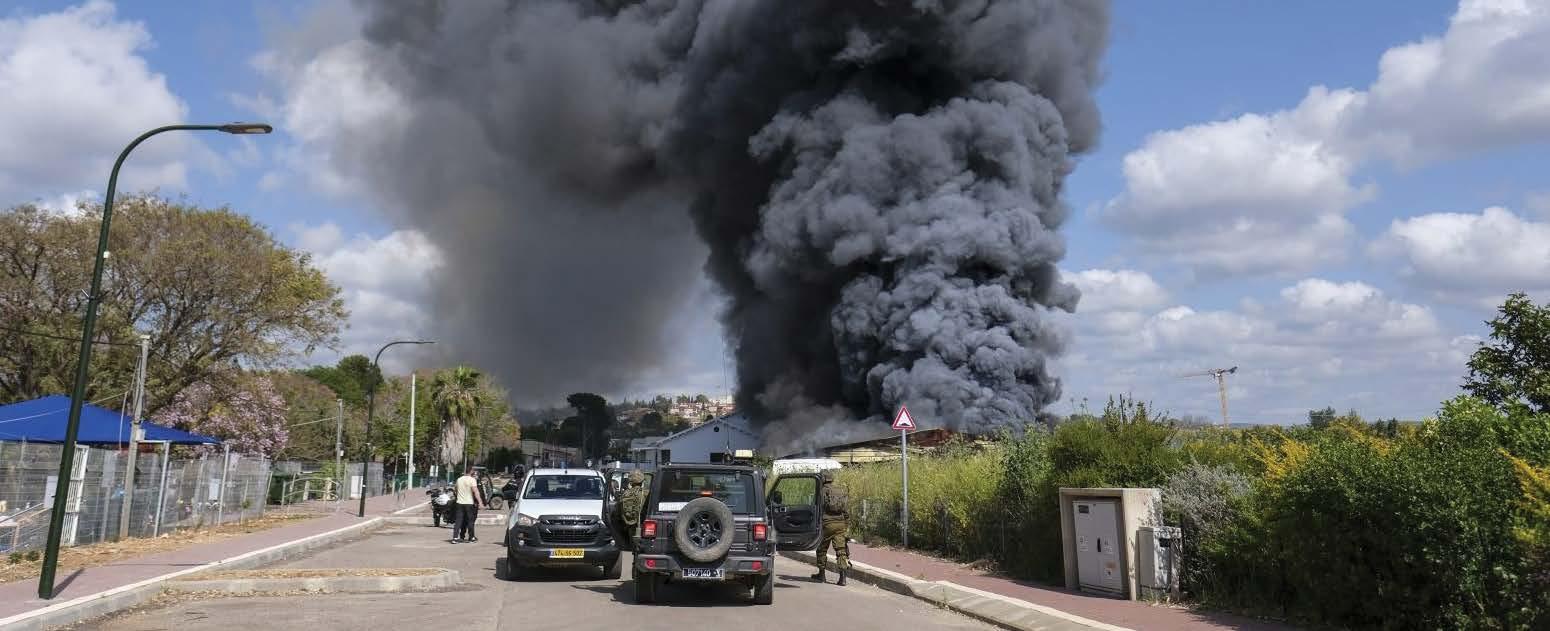
Meanwhile, towns and villages in Northern Israel are rushing to bolster their civilian defenses by upgrading and adding bomb shelters. Recent studies show the North sorely lacks adequate shelters for its growing population, especially given Hezbollah’s arsenal of over 200,000 rockets and missiles.
T he International Christian Embassy Jerusalem became aware of this need several years ago and has been working to supply portable bomb shelters to these vulnerable areas. Over the past decade, the ICEJ has donated nearly 200 mobile bomb shelters to vulnerable Israeli communities, with most going to towns along the Gaza border facing frequent Hamas rocket attacks, but we have managed to place some
50 shelters in Northern Israel already.
T hanks to a Swiss Christian family’s generosity, we are delivering six new bomb shelters to the town of Shlomi, which was struck by a rocket fired from southern Lebanon on the first day of Passover. The missile landed in a busy intersection—with a bank, a synagogue, a store, and a law firm on each corne.
A town of 9,000 residents that borders Lebanon, Shlomi has suffered its share of rocket attacks over recent decades. But city officials say the town is not prepared for what is likely to come in a future war with Hezbollah. Rocket alarms in Shlomi often give only two to three seconds of warning for incoming short-range mortars. Half the residents still live in the “old city” of Shlomi, which has no shelters. The government has promised hundreds of millions of shekels for shelters in the North, but little has come so far.
T he ICEJ’s newest shelters are being placed in public areas to serve the whole community, such as playgrounds, synagogues, and at bus stops.
In addition, ICEJ USA is providing funds to refurbish 53 existing underground shelters in Shlomi. The work will involve sealing water leaks, fixing faulty electrical networks, installing new lighting, water pumps, drainage systems, and fans for improved ventilation, applying fresh coats of paint, and much more.
Please help us provide more bomb shelters for communities in Northern Israel.
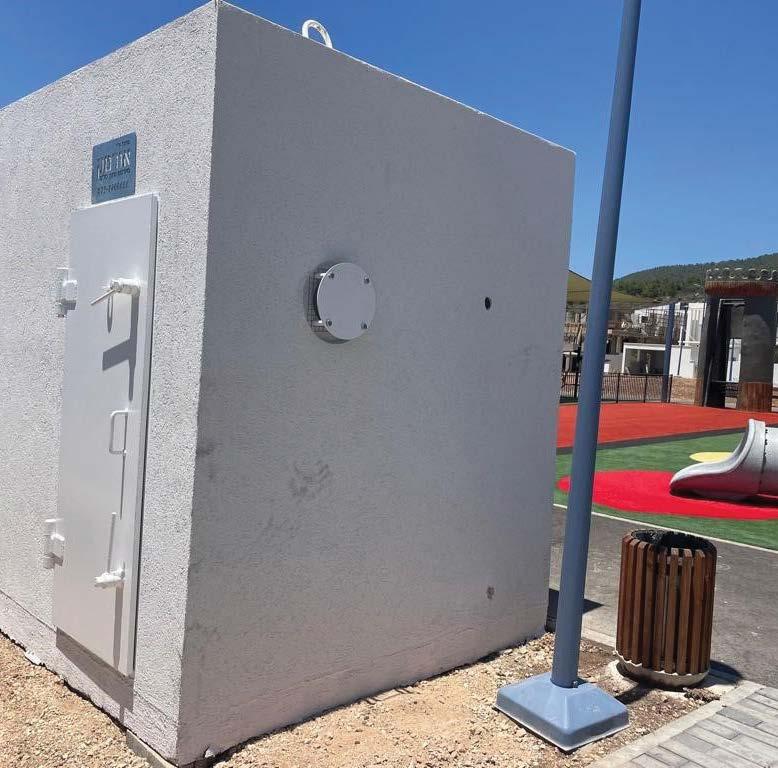
16 |SEPTEMBER 2023 ICEJ AID
Donate today at: www.icejusa.org/bomb-shelters
The aftermath of a rocket strike in the town of Shlomi during Passover. (AP photo)
An ICEJ-sponsored bomb shelter being installed in Shlomi, Northern Israel
HAIFA HOME HAPPENINGS
BY YUDIT SETZ, ICEJ DEPUTY AID DIRECTOR & SHAY DROR, ICEJ VOLUNTEER
Haifa Home Welcomes Newest Resident
The ICEJ’s Home for Holocaust Survivors in Haifa remains an interesting place to live and work, as we recently saw when welcoming our newest resident, Galina Voloshin.
Galina was born in 1936 in Ushomir, a small Jewish village near Kyiv. When the war broke out in Ukraine in June 1941, Galina’s father was mobilized. The family received only one letter from him, in which he urged Galina’s mother to take care of herself and their children.
Galina’s mother was a secretary of the local Communist party and knew all the communists in the area, so the family had to be evacuated. Galina, her sister, and their grandmother had to sit in an open cart, waiting for Galina’s mother to return, while harrowing sounds of sirens bellowed and dogs howled, leaving Galina with a lifelong fear of dogs.
T he family escaped to the Stalingrad region, in the heat of the summer, where they lived for several months, during which time Galina’s grandmother and little sister died.
Everyone believed the Germans would not reach Stalingrad, but in 1942, the enemy laid siege to the city. Galina and her mother escaped again, this time by train. During the journey, several air raids sounded, forcing the train to stop and everyone to hide in the woods. They finally arrived in Ural at the end of August, but the weather had turned bitterly cold. Galina’s mother secured work at a school and planted a vegetable garden with her pupils that saved their lives. Galina would sit in bed wrapped in
a blanket trying to keep warm until her mother returned from work.
After the war, the two returned to Ukraine, where Galina started school. She eventually studied at university to become an engineer and worked in this field until retirement.
In 1997, at the age of 61, Galina and her 80-yearold mother made Aliyah to Israel, where Galina continued to care for her aging mother and volunteered to help other Soviet Jewish immigrants. She has received many certificates of recognition for her contributions.
Galina moved into the Haifa Home for Holocaust Survivors in June and is quite happy to live here. “When I came to the dining room for the first time, I was warmly welcomed and greeted by residents and staff alike. Everyone was so friendly, and I immediately felt at home,” she shared.

A n Incredible Reunion with a Tearful Closure
An unexpected visit to the Haifa Home recently brought a long-awaited closure to 95-year-old resident Sarah Zamir. Born as Ilse Böhm, Sarah grew up in a religious Jewish family near Breslau, in Silesia. In 1939 the family fled the Nazi regime for Belgium hoping for a safer life; however, deportations of Belgium’s Jews soon began. Sarah’s family was sent to concentration camps, never to return. But a kind Catholic couple from Antwerp took in 14-year-old Sarah. “They were not just good people,” Sarah recalled. “They were like angels.”
Sarah’s tearful reunion came about due to the
work of Charlie Knight, a British historian of German Jewish refugees from the 1930s and 40s. Through his research, Charlie found letters dated from 1939 to 1940 hidden in an archive, letters sent back and forth between Sarah’s father, Ernst Böhm, and his cousin. Among them, Charlie found a postcard written by Ernst’s daughter, Ilse, whose fate was not initially clear. Further research revealed that she had survived, immigrated to Israel, and was now named Sarah Zamir.
After seeing Sarah featured in an ICEJ Germany video posted on social media, Charlie contacted the Christian Embassy, and soon enough, the two met at the Home in Haifa, where Sarah told Charlie in detail about her rescuers. The information Sarah provided prompted Charlie to continue his research that eventually led to identifying the Catholic couple who saved Sarah’s life and locating their family
T he couple’s great-grandson, Vince, had heard about Ilse from his grandfather, who was her age and lived alongside her in his parents’ home. As he grew older, the grandfather expressed hope that Ilse had lived a long, healthy life. When he learned about Sarah, Vince decided to come to Israel to meet her!
Sarah could hardly believe it was happening! Her own granddaughter was there for the reunion and said: “It was touching beyond words and an honor to meet the family that saved my grandma.” Vince agreed: “We were overcome by emotion—the first thing we did when we met was just cry. But then it became natural, and we talked as if we had known each other forever.”
Help
ICEJ HOME FOR HOLOCAUST SURVIVORS
provide
shelter to others like
Galina and
Sarah living at the
Haifa
Home for Holocaust Survivors. Give today at: www.icejusa.org/haifa
Galina receives care by one of the Haifa Home staff caregivers.
17 |WORD FROM JERUSALEM
WHAT WE LEARN FROM THE LAW
By Dr. Susan Michael, ICEJ USA Director
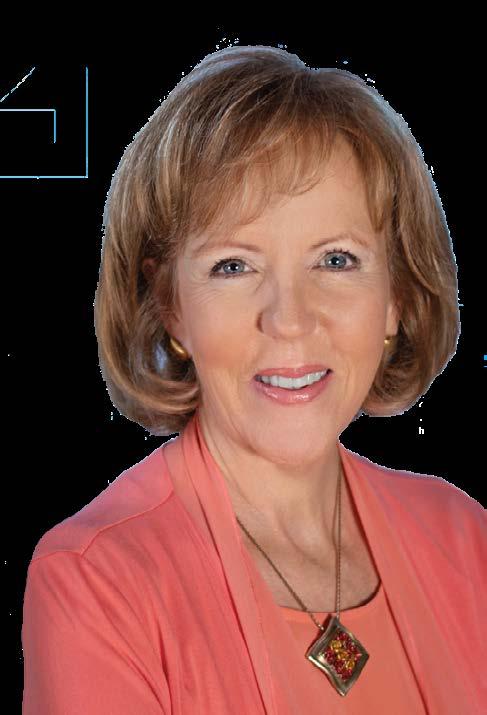
After God freed the children of Israel from Egyptian slavery, He brought them to the base of Mount Sinai, where He gave them His law with the expectation that they would keep it and thus be set apart from the surrounding, godless nations. Those nations would see how different Israel was as a result of keeping the law and say, “Surely this great nation is a wise and understanding people” (Deuteronomy 4:7). They would be drawn toward Israel’s God.
Yet when people read the word “law” in the Bible, they often relate it to something strict and legalistic—even boring. For this reason, many skim over sections in the Bible that talk about the law without realizing that in so doing, they miss out on the richness that comes from learning about it.

The law is within the first five books of the Bible, known as the Torah to the Jewish community. The word “torah” means “teaching” or “instruction,” like a wise man instructing his son. God always meant for His law to bring freedom, not bondage, and it was never meant for salvation—that would come later in the person of Jesus.
And God had a great purpose in initiating it.
The Law Revealed God’s Character to His People
Through His Torah, God revealed Himself and His righteous character to His children. God is perfectly righteous and Holy (set apart) and cannot have fellowship with sin. Thus, God’s people also had to be righteous to approach Him, an unsolvable problem for sinful man. But God loved His children and wanted a relationship, so He provided a solution: He taught the Israelites how to purify themselves so they could draw near to Him correctly. Through the purification requirements within the law, we see God’s grace and mercy, but we also see He is holy and to be revered and obeyed.
The Law Instructed God’s People
Part of God’s law was His moral code (the 10 Commandments) against things like murder, stealing, and coveting. But there were hundreds of additional rules within God’s law that were instructive for Israel.
For example, His requirement to rest on Sabbath taught the children of Israel that to be in relationship with God, they had to abide in His restful presence every seventh day. God designed the Feasts of the Lord, also within His law, to remember and commemorate His goodness and mighty acts in history while passing this knowledge on to future generations.
The Law Protected and Directed God’s People
God’s law was to be like a hedge of protection around His people. The apostle Paul tells us that God’s instruction was like a tutor acting like a bodyguard to protect His people and ensure they arrived safely to their teacher, preserving their lives until the “date set by the Father” (Galatians 4:2) when God’s Spirit would lead them to their true Teacher—their Messiah.
The Law Covered God’s People
Yet all the while, God knew it was impossible to keep the law—no human being could. Perhaps this is why some see it as legalistic and binding. Yet within God’s law, He also established the priesthood and the sacrificial system, which included the Day of Atonement, or Yom Kippur. Though the children of Israel could never keep every law all the time, once a year on Yom Kippur, God provided a way to receive a temporary covering for their shortcomings through specific sacrifices. Yom Kippur foreshadowed a coming day when God would not just cover Israel’s sin but remove it when Jesus, our Great High Priest, died on the cross—God’s once-for-all sacrifice.
The Law Pointed God’s People to Messiah
Through the law, God’s people would learn about sin, sacrifice, sanctification, their Messiah, and their need for a Savior who would one day come to dwell among them and remove their sin. God’s heart was always to tabernacle among His people and fellowship with them from generation to generation—this was the purpose behind the law.
For believers today, the law points us to Jesus and how His blood shed on the cross is the fulfillment of centuries of sacrifices to cover for sin, giving anyone who believes access to the Father.
The law is anything but boring—in fact, it is a blessing for us all.
Text “zion” to 72572 to receive an alert each Friday for her Shabbat Shalom devotional and end your week with a little inspiration and peace.
Plan to travel to Israel on an ICEJ Tour: www.icejusa.org/tours

18 |SEPTEMBER 2023
ICEJ PODCAST: OUT OF ZION
Dr. Susan Michael is USA Director of the International Christian Embassy Jerusalem and host of the Out of Zion podcast.
SEND A GIFT FOR ISRAEL’S 75TH
are thrilled to be celebrating this year the 75th anniversary of Israel’s rebirth as a nation on May 14, 1948. The Jewish State and people have overcome so much since God began regathering them to their ancestral homeland according to His covenant promises.


The International Christian Embassy Jerusalem has been standing at Israel’s side for 43 years now, and we have witnessed the power of God’s Word at work in the way Christians worldwide have responded to the prophetic call of Scripture to be involved in this great ingathering.
As scores of Jewish exiles have made the journey home to the Land of Israel, Christians have partnered with our ministry to help 180,000 of them reach the promised land.


www.icej.store

NAHARA DEAD SEA PRODUCTS

1. Body Lotion (8.5 oz)• $13.00*
2. Body Scrub (8.5 oz) • $15.00*
3. Hand Cream (2.9 oz) • $9.00*
4. Hand Wash (11.8 oz) • $12.00*
5. Hand and Body Gift Set • $30.00*
6. Shower Gel (8.5 oz) • $11.00*
Among the Jews returning to the Land are many Holocaust Survivors, and Christians worldwide have assisted us in caring for them.
Israel also has faced many times of crisis and war in the Land and yet always emerged victorious, with the support and admiration of their Christian friends. In recent years, this support has often taken the form of portable bomb shelters provided to Israeli communities vulnerable to the constant threat of rocket attacks.
On Israel’s 75th anniversary, we want to encourage you to consider sending a birthday gift of $75 to mark this special occasion. These gifts will be used to continue our vital work in Israel, such as sponsoring more Aliyah flights, caring for needy Holocaust Survivors, and providing more bomb shelters for Israeli communities under serious rocket threat.
For full
72” x 22” prayer shawl with matching bag $25.00*
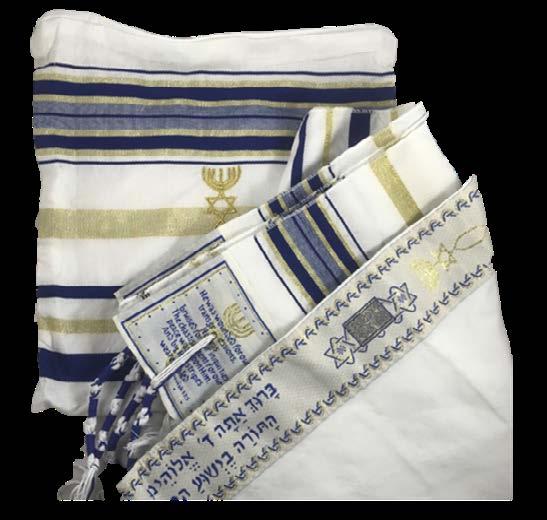
7. Body Mist (8.5 oz) • $15.00* $9.99
ANOINTING OILS

Cassia, Cinnamon, Frankincense
Henna, Holy Anointing Oil, Prince of Peace, Rose of Sharon
MEZUZAH
Silver-colored with a gold-colored “Grafted-in” symbol. Includes the blessing from Deuteronomy. $9.99

product
FALL SALE! VISIT OUR ONLINE STORE AND RECEIVE A 35% DISCOUNT ON ALL PURCHASES
and use the discount code: “FALL.”
TODAY AT: www.icejusa.org/donate-online
descriptions, visit our online store!
www.ICEJ.store
DONATE
We
NEW COVENANT PRAYER SHAWL
You can still
JOIN US ONLINE
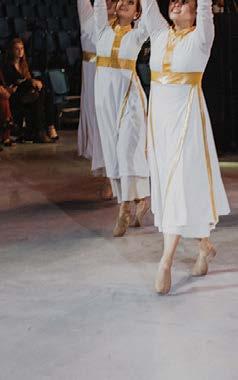
Basic Package
$50 USD

• Full registration to 8-day gathering
• Videos On Demand accessible until end of January 2024

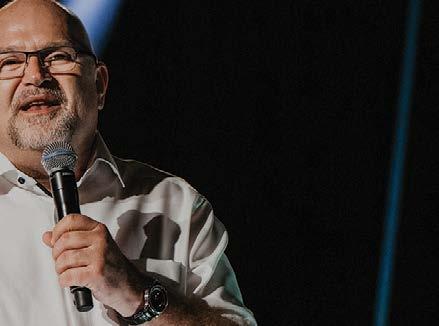
• Digital certificate of participation
King of all the Earth
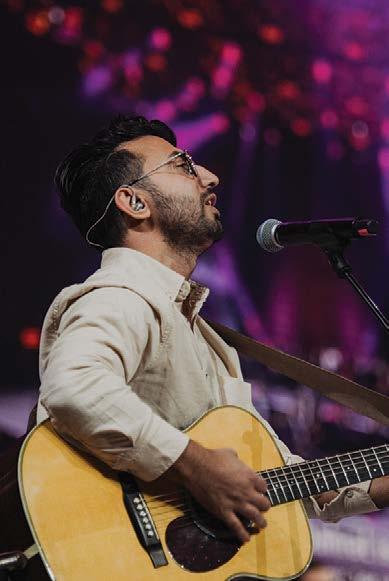

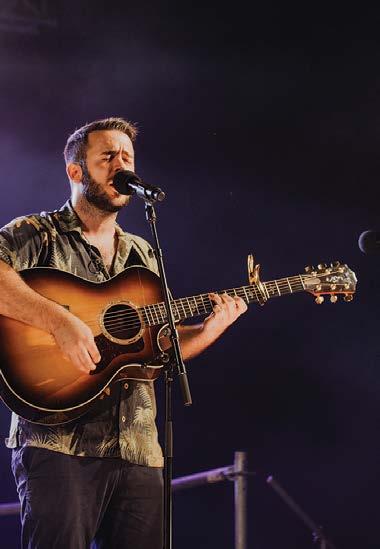

$109.99 USD
• Full registration to 8-day gathering

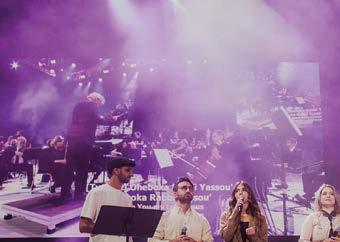
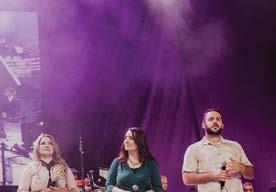

• Videos On Demand accessible until end of July 2024
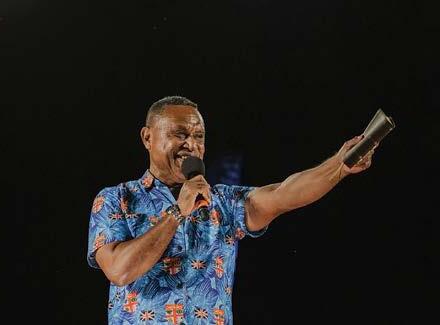


• Digital certificate of participation

• Feast T-shirt*
*Free Shipping included for the Feast merchandise.

First-Fruit Package
Upgrade to a First-Fruit package for $159.99 and bless Israel with your Feast offering of $50 USD
Upgrade of King of All the Earth Package
First-Fruit Plus Package
Upgrade to a FirstFruit Plus package for $209.99 and bless Israel with your Feast offering of $100 USD
Upgrade of King of All the Earth Package

Celebrate the Feast of Tabernacles 2023! Register online at: www.icejfeast.org 29
2023
September - 6 october
“For God is the King of all the earth; Sing praises with understanding.”
Psalm 47:7
A choice of three colours












 KAREN ENGLE, ICEJ USA MANAGING EDITOR
KAREN ENGLE, ICEJ USA MANAGING EDITOR



 B Y DAVID R. PARSON S ICEJ VICE PRESIDENT AND SENIOR SPOKESMAN
B Y DAVID R. PARSON S ICEJ VICE PRESIDENT AND SENIOR SPOKESMAN
















 BY ESTER HEINZMANN, ICEJ GERMANY
BY ESTER HEINZMANN, ICEJ GERMANY
































